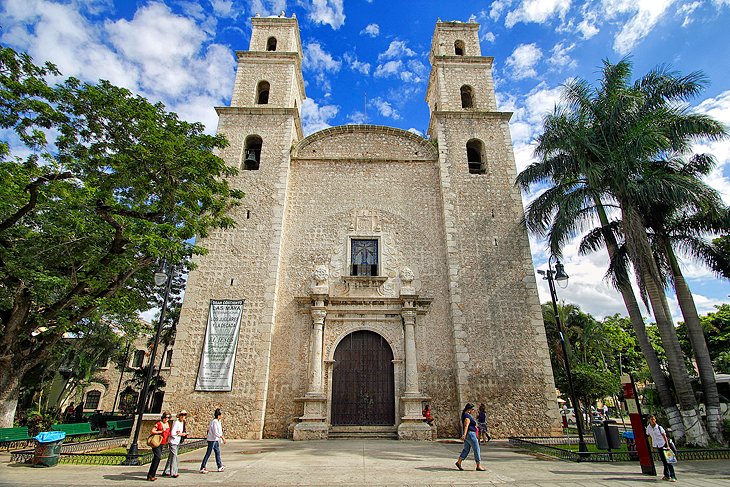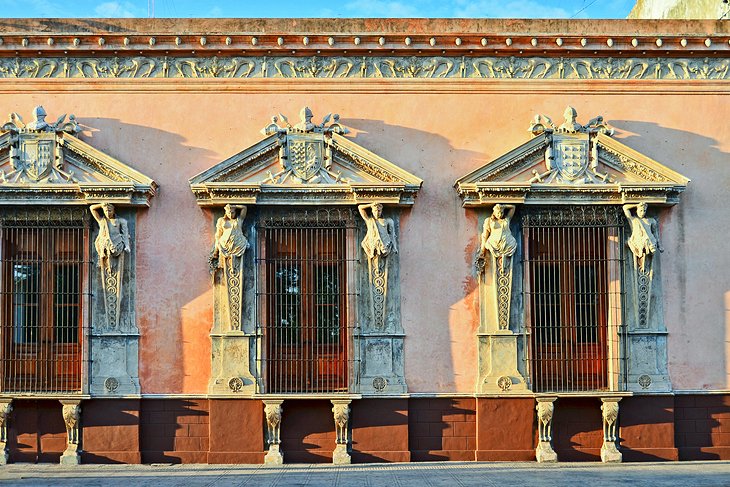This will be the only time I post in English, or the last time I hope to post in English. I would like for my friends and family to know a little more about Mérida and México before I take off! Mexico has 31 states and one federal district known as DF or Mexico City. Mexico is geographically diverse with mountains to the east and west of central Mexico cradling to the peninsula, known as the Yucatán Peninsula. In the north there is desert land and the south hosts a tropical climate including the savanna of the Yucatán Peninsula. The state I will be in is the Yucatán. Other important cities in this state are Valladolid, Progreso, Izamal, Tizimín, Motul, and Ticul. Yes, Cancun is in the Yucatán, but it's a four hour drive by car. So no, I probably won't see you there for spring break.
The red arrow points to where Mérida is located:

Believe it or not, Mexico has the largest Spanish-speaking population in the world, with almost one-third of all Spanish native speakers. The official language is Spanish, but native languages are still spoken. Additionally 83% of Mexicans are Roman Catholic, making Mexico the second largest Catholic community in the world. The feast of Our Lady of Guadalupe, the patron saint of Mexico, is usually regarded as the most important religious holiday in their country. There is also a Jewish and Islamic presence, as well as a small Buddhist population. The Mayan religion is still practiced today, but it has been combined with Catholic traditions.
Below: Parque Cepada Peraza and the Church of Jesús

Political stability furthered economic and social development in Mexico. Mexico´s economy has gone from primarily agriculture to the 13th most important economy in the world. Recent economic policies have influenced the process of this economic modernization. In 1986 Mexico entered the GATT (General Agreement on Tariffs and Trade), and in 1994 signed the NAFTA (North American Free Trade Agreement) with the United States and Canada.

Above: Casa Montejo
Mérida´s nickname is La Ciudad Blanca, or The White City. Mérida is a colonial city founded in 1542 by Franciso de Montejo or "El Mozo". The indigenous group that lived in this area were the Mayans. Mérida has the highest percentage of indigenous persons of any large city in Mexico.. Mérida was built on top of the Mayan city T´ho after their five pyramids were destroyed to build the cathedral and other important monuments. Mérida is the capital city in the state of the Yucatán with a population of about 800,000.

Above: Chichen-Itzá
Interesting facts about the Mayans and Mérida:
- The Mayans were so advanced in mathematics and astronomy that their calendar was the most accurate until the 21st century.
- The Mayans were the first civilization that could predict solar and lunar eclipses.
- The main pyramid of the Mayan ancient city of Chichen-Itzá is one of the seven wonders of the world.
- Chewing gum or chicle was discovered by the Mayans.
- Mayans used sweat baths (known today as the modern saunas) to purify their body, I think they were on to something here.
- The Yucatán Peninsula is essentially limestone rock covered with plant life. Which provides us with the absence of rivers, leaving us with beautiful cenotes (underground caves).
- Chocolate, aguacate, and cacahuate are all Nahuat´l words and ancient products of the peoples of Mesoamerica. Futhermore, chocolate played an important role in both royal and religious practices of the Maya religion. There is evidence of cacao beverages dating to 1900 B.C.
Below: a cenote in the Yucatán

So my dear friends and family, when you ask me, Why Mérida? Why México? Why the Yucatán? It appears that everything about this place should tell you exactly why I chose to study abroad here. If my words can´t convince you, let the pictures speak for themselves.
Hasta la proxima,
Jacqueline